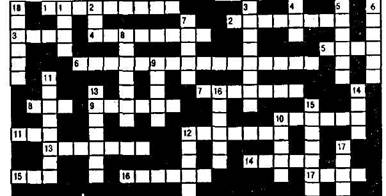Fill in the squares with nouns upon the models
71 Unit 5. Computer Systems: An Overview
 Crossword 1.
Crossword 1.

Horizontally
1. A more favourable position; gain or benefit. 2. The fol
lowing one thing after another. 3. Examination, experiment or
trial. ^. The process opposite to multiplication. 5. The heart,
the central part of anything. 6. The science dealing with micro-
circuits. 7. Thickness, compactness; example: packing___ .
8. Application. 9. The doing smth; state of being in motion. 10. To put in writing, to print for future use. 11. Goal, purpose. 12. Memory. 13. Advantage, help; anything contributing to an improvement in condition. 14. Intelligence, mental ability. 15. Method or manner of doing something. 16. Display. 17. A tiny crystall, containing an integrated circuit.
Vertically
1. Information. 2. Help. 3. Reply, answer or reaction. 4. A group of elements. 5. A unit keeping information. 6. Approach; means of approaching, getting. 7. A style or design; imitation of an existing object. 8. Different form of some thing; condition or quality. 9. A mistake.10. A switch. 11. A fitting together of parts to make a whole. 12. Rate. 13. A model; cliche; standard. 14. A system of symbols used for entering data into the computer. 15. A branch of systematized knowledge of nature. 16. An attempt; a hard try. 17. A device. 18. An example, a sample, a model.

|
Unit 6
FUNCTIONAL ORGANIZATION OF THE COMPUTER
 1. Ознакомьтесь с терминами текста 1.
1. Ознакомьтесь с терминами текста 1.
operation [apa'reifn] — операция; работа; действие; срабатывание
to relate [n'leit] — связывать; устанавливать отношения a broad view ['bro:d 'vju:] — широкий взгляд, обзор
unit I'jumit] — устройство; модуль, блок; узел; элемент; ячейка
input — ввод; устройство ввода; вводить; подавать на вход
to insert [m'sa:t] — вставлять; вносить; включать storage memory — память; запоминающее устройство available [a'veibbl] — доступный; имеющийся в наличии at the appropriate time — в нужное время
arithmetic-logical unit — арифметико-логическое устройство
output — вывод; устройство вывода; выводить; подавать на выход
to remove [n'mu:v] — удалять; устранять; вынимать; исключать
control unit — блок управления
cause ['ko:z]— заставлять; вынуждать; быть причиной; причина; основание
to feed (fed, fed) — подавать; питать; вводить (данные)
to interpret [m'tapnt] — интерпретировать; истолковывать
to issue commands ['isju: ka'marndz] — выдавать команды pulse — no-pulse — (есть) импульс — холостой импульс
73 Unit 6. Functional Organization of the Computer
 2. Прочтите текст и назовите основные функциональные блоки компьютера и ихназначение.
2. Прочтите текст и назовите основные функциональные блоки компьютера и ихназначение.
Text 1.FUNCTIONAL UNITS OF DIGITAL COMPUTERS
As we know, all computer operations can be grouped into five functional categories. The method in which these five functional categories are related to one another represents the functional organization of a digital computer. By studying the functional organization, a broad view of the computer is received.
The five major functional units of a digital computer are:
1) Input— to insert outside information into the machine;
2) Storage or memory — to store information and make it avail
able at the appropriate time; 3) Arithmetic-logical unit — to
perform the calculations; 4) Output — to remove data from the
machine to the outside world and 5) Control unit — to cause
all parts of a computer to act as a team.
Figure 5 shows how the five functional units of the computer act together. A complete set of instructions and data are usually fed through the input equipment to the memory where they are stored. Each instruction is then fed to the control unit. The control unit interprets the instructions and issues commands to the other functional units to cause operations to be performed on the data. Arithmetic operations are performed in the arithmetic-logical unit, and the results are then fed back to the mem-
Английский язык. Основы компьютерной грамотности 74
 огу. Information may be fed from either the arithmetic unit or the memory through the output equipment to the outside world. The five units of the computer must communicate with each other. They can do this by means of a machine language which uses a code composed of combinations of electric pulses. These pulse combinations are usually represented by zeros and ones, where the one may be a pulse and the zero — a no-pulse. Numbers are communicated between one unit and another by means of these one-zero or pulse — no-pulse combinations. The input has the additional job of converting the information fed in by the operator into machine language. In other words, it tran-saltes from our language into the pulse — no-pulse combinations understandable to the computer. The output's additional job is converting the pulse — no-pulse combinations into a form understandable to us, such as a printed report.
огу. Information may be fed from either the arithmetic unit or the memory through the output equipment to the outside world. The five units of the computer must communicate with each other. They can do this by means of a machine language which uses a code composed of combinations of electric pulses. These pulse combinations are usually represented by zeros and ones, where the one may be a pulse and the zero — a no-pulse. Numbers are communicated between one unit and another by means of these one-zero or pulse — no-pulse combinations. The input has the additional job of converting the information fed in by the operator into machine language. In other words, it tran-saltes from our language into the pulse — no-pulse combinations understandable to the computer. The output's additional job is converting the pulse — no-pulse combinations into a form understandable to us, such as a printed report.